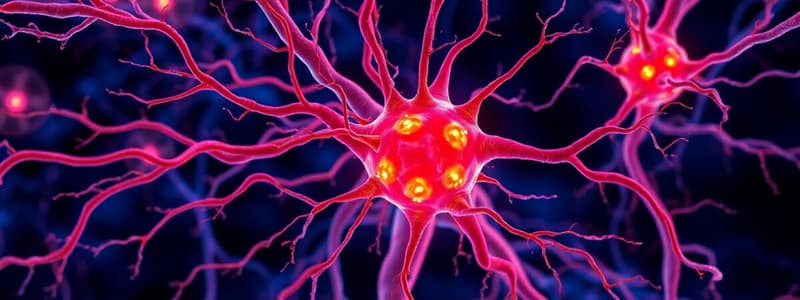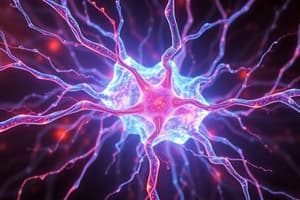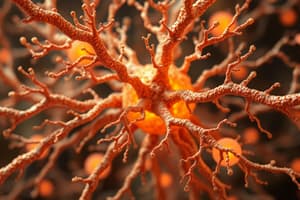Podcast
Questions and Answers
What is the primary role of neurons in the nervous system?
What is the primary role of neurons in the nervous system?
- Maintain structural integrity
- Conduct impulses (correct)
- Support organ function
- Produce hormones
Which type of neuron carries impulses from receptors to the central nervous system?
Which type of neuron carries impulses from receptors to the central nervous system?
- Multipolar neurons
- Sensory neurons (correct)
- Interneurons
- Motor neurons
What is found in the cell body of a neuron that is responsible for synthesizing proteins?
What is found in the cell body of a neuron that is responsible for synthesizing proteins?
- Dendrites
- Nissl bodies (correct)
- Axons
- Synapses
Which statement accurately describes unipolar neurons?
Which statement accurately describes unipolar neurons?
Which of the following statements about the central nervous system (CNS) is true?
Which of the following statements about the central nervous system (CNS) is true?
What are synapses primarily used for in neurons?
What are synapses primarily used for in neurons?
Which type of neuron is primarily involved in communication between sensory and motor neurons?
Which type of neuron is primarily involved in communication between sensory and motor neurons?
Which of the following best describes the structure of bipolar neurons?
Which of the following best describes the structure of bipolar neurons?
What role do astrocytes play in the nervous system?
What role do astrocytes play in the nervous system?
Which neuroglial cell type is responsible for generating the myelin sheath around axons in the central nervous system?
Which neuroglial cell type is responsible for generating the myelin sheath around axons in the central nervous system?
What is the primary function of microglia in the central nervous system?
What is the primary function of microglia in the central nervous system?
Where are ependymal cells primarily located?
Where are ependymal cells primarily located?
What is the main difference between gray matter and white matter in the nervous system?
What is the main difference between gray matter and white matter in the nervous system?
What is the function of Schwann cells in the peripheral nervous system?
What is the function of Schwann cells in the peripheral nervous system?
What facilitates the process of saltatory conduction in axons?
What facilitates the process of saltatory conduction in axons?
Which central neuroglial cell type is least common within the central nervous system?
Which central neuroglial cell type is least common within the central nervous system?
What is the primary function of satellite cells in the peripheral nervous system?
What is the primary function of satellite cells in the peripheral nervous system?
What distinguishes the myelination process of Schwann cells in myelinated versus unmyelinated axons?
What distinguishes the myelination process of Schwann cells in myelinated versus unmyelinated axons?
Which connective tissue layer surrounds individual nerve fibers and their associated Schwann cells?
Which connective tissue layer surrounds individual nerve fibers and their associated Schwann cells?
What is the main role of macrophages in neuroregeneration after an injury?
What is the main role of macrophages in neuroregeneration after an injury?
What is the approximate rate of axonal growth in large nerves after regeneration?
What is the approximate rate of axonal growth in large nerves after regeneration?
Which type of neuron typically has numerous dendrites and a single axon, often classified as multipolar?
Which type of neuron typically has numerous dendrites and a single axon, often classified as multipolar?
What characteristic differentiates unipolar neurons from bipolar neurons?
What characteristic differentiates unipolar neurons from bipolar neurons?
Which of the following best describes the location of most neuron cell bodies?
Which of the following best describes the location of most neuron cell bodies?
Which type of supporting cell in the central nervous system is responsible for maintaining the blood-brain barrier?
Which type of supporting cell in the central nervous system is responsible for maintaining the blood-brain barrier?
How do sensory neurons primarily function within the nervous system?
How do sensory neurons primarily function within the nervous system?
Which of the following statements about neuroglial cells is correct?
Which of the following statements about neuroglial cells is correct?
Which component of a neuron is primarily responsible for transmitting impulses away from the cell body?
Which component of a neuron is primarily responsible for transmitting impulses away from the cell body?
Which of the following structures are included in the peripheral nervous system?
Which of the following structures are included in the peripheral nervous system?
What characteristic distinguishes white matter from gray matter in the nervous system?
What characteristic distinguishes white matter from gray matter in the nervous system?
Which type of glial cell is primarily involved in forming the myelin sheath around axons in the peripheral nervous system?
Which type of glial cell is primarily involved in forming the myelin sheath around axons in the peripheral nervous system?
Which function is primarily associated with microglia in the central nervous system?
Which function is primarily associated with microglia in the central nervous system?
What is the primary role of ependymal cells in the central nervous system?
What is the primary role of ependymal cells in the central nervous system?
How do astrocytes facilitate metabolic exchange between neurons and blood?
How do astrocytes facilitate metabolic exchange between neurons and blood?
In which specific part of the nervous system do oligodendrocytes primarily function?
In which specific part of the nervous system do oligodendrocytes primarily function?
What unique structural feature is found in the apical surface of ependymal cells?
What unique structural feature is found in the apical surface of ependymal cells?
Which function is specifically associated with the nodes of Ranvier?
Which function is specifically associated with the nodes of Ranvier?
What is the role of macrophages in the process of neuroregeneration?
What is the role of macrophages in the process of neuroregeneration?
What structure holds individual nerve fibers together within a peripheral nerve?
What structure holds individual nerve fibers together within a peripheral nerve?
How does the process of myelination differ between myelinated and unmyelinated axons?
How does the process of myelination differ between myelinated and unmyelinated axons?
What is the growth rate of axons following injury in small nerves?
What is the growth rate of axons following injury in small nerves?
Which type of corpuscle is responsible for sensing vibration and pressure?
Which type of corpuscle is responsible for sensing vibration and pressure?
Flashcards are hidden until you start studying
Study Notes
Nervous Tissue
- Nervous system enables the body to respond to external changes and controls internal organ functions.
- Neurons: Specialized cells that conduct impulses, they are the functional unit of the nervous system.
- Supporting cells: Non-conducting cells that surround neurons and their processes.
Central Nervous System (CNS)
- Composed of the brain and spinal cord.
- Contains gray matter with neuron cell bodies and supporting cells.
- Contains white matter with myelinated neuron processes and a few supporting cells.
Peripheral Nervous System (PNS)
- Includes all nervous tissue outside the CNS.
- Contains cranial nerves, spinal nerves, and ganglia.
Neurons
- Consist of a cell body, axon, and dendrites.
- Axon: Transmits impulses away from the cell body.
- Dendrites: Shorter processes that transmit impulses toward the cell body.
- Communicate through junctions called synapses.
Neuron Types
- Motor neurons: Transmit impulses from the CNS or ganglia to effector cells.
- Sensory neurons: Transmit impulses from receptors to the CNS.
- Interneurons: Communicate between sensory and motor neurons.
Neuron Structures
- Multipolar neurons: Possess many dendrites and a single axon.
- Bipolar neurons: Have a single axon and a single dendrite extending from the cell body.
- Unipolar neurons: Sensory neurons with one short process that branches into two.
Supporting Cells: Neuroglia
- Called central neuroglia in the CNS.
- Astrocytes: Most common type, connect with capillaries for metabolic exchange between neurons and blood, have a star-shaped appearance.
- Oligodendrocytes: Generate the myelin sheath for multiple axons, increasing the speed of action potential conduction.
- Microglia: Play a role in immune defense and can become phagocytic.
- Ependymal cells: Line the ventricles of the brain and the central canal of the spinal cord, have microvilli and cilia.
Gray and White Matter
- Gray matter: Contains neuron cell bodies, unmyelinated dendrites, and supporting cells.
- White matter: Contains myelinated neuron processes and a small number of supporting cell bodies.
Supporting Cells in the Peripheral Nervous System (PNS)
- Schwann cells: Primary supporting cells in the PNS, form myelin sheaths around individual axons.
- Satellite cells: Maintain a controlled microenvironment for neurons in ganglia of the PNS.
Peripheral Nerve Structure
- Myelinated axons: One Schwann cell completely surrounds a single axon, forming segments of myelin sheath.
- Unmyelinated axons: Multiple axons are enveloped by a single Schwann cell, with no tightly wrapped layers, forming grooves on the cell surface.
Connective Tissue in Peripheral Nerves
- Endoneurium: Surrounds individual nerve fibers and Schwann cells.
- Perineurium: Surrounds a group of nerve fibers (nerve fascicles).
- Epineurium: Surrounds the entire peripheral nerve and fills spaces between fascicles.
Mechanoreceptors
- Lamellar corpuscles: Sensitive to vibration and pressure, oval-cylindrical in shape, wrapped by a layer of connective tissue with concentric layers.
Neuroregeneration
- Neurons do not divide, but can partially regenerate after injury.
- Regeneration process:
- Macrophages phagocytize debris and stimulate Schwann cell growth.
- Schwann cells form new myelin sheaths around axonal sprouts.
- Regeneration can take up to a year.
- Axonal growth rate is faster in larger nerves.
Nervous Tissue
- The nervous system allows the body to respond to changes in its environment and controls internal organ functions. It comprises neurons and supporting cells.
- Neurons are specialized cells that conduct impulses, while supporting cells provide support and do not conduct impulses.
- The neuron is the functional and structural unit of the nervous system.
- The central nervous system (CNS) consists of the brain and spinal cord, containing gray and white matter.
- The peripheral nervous system (PNS) includes all nervous tissue outside the CNS, like cranial nerves, spinal nerves, and ganglia.
Neuron Structure
- Each neuron has a cell body, an axon, and dendrites.
- The axon transmits impulses away from the cell body, while dendrites carry impulses towards it.
- Neurons communicate with each other through specialized junctions called synapses.
Neuron Types
- Motor neurons: Carry impulses from the CNS or ganglia to effector cells.
- Sensory neurons: Carry impulses from receptors to the CNS.
- Interneurons: Communicate between sensory and motor neurons.
Multipolar neurons
- They have multiple dendrites and a single axon, typical of motor neurons and interneurons.
Bipolar neurons
- They have a single axon and a single dendrite extending from the cell body, found in the retina and other sensory organs.
Unipolar neurons
- Also known as pseudounipolar neurons, are sensory neurons with one short process branching from the cell body.
- They are not easily seen in a single section due to their length.
Supporting Cells: Neuroglia (Central)
- Astrocytes: The most common supporting cell.
- They connect with capillaries through "end-feet," facilitating metabolic exchange between neurons and blood.
- They have a star-shaped appearance.
Supporting Cells: Neuroglia (Central)
- Oligodendrocytes: Generate the myelin sheath for up to 50 axons.
- The myelin sheath insulates axons, enhancing the speed of action potential conduction.
- Damage to the myelin sheath, as in multiple sclerosis, leads to demyelination and impaired axonal function.
Supporting Cells: Neuroglia (Central)
- Microglia: Less common type, they play a role in immune defense and can become phagocytic.
Supporting Cells: Neuroglia (Central)
- Ependymal cells: Form the ependyma, lining the ventricles of the brain and the central canal of the spinal cord.
- They have microvilli and cilia on their apical surface.
Gray and White Matter
- Gray matter contains neuron cell bodies, unmyelinated dendrites, and supporting cells.
- White matter contains myelinated axons and a small number of cell bodies from supporting cells.
Supporting Cells: Neuroglia (Peripheral)
- Schwann cells: The main supporting cell in the PNS.
- They wrap their plasma membrane around axons, forming segments of the myelin sheath.
- Each Schwann cell creates one myelin sheath segment between nodes of Ranvier.
- Gaps between segments allow saltatory conduction, enhancing nerve impulse propagation.
Supporting Cells: Neuroglia (Peripheral)
- Satellite cells: Maintain a controlled environment around nerve cell bodies in PNS ganglia.
Peripheral Nerve Structure
- In myelinated axons, one Schwann cell wraps around a single axon multiple times.
- In unmyelinated axons, a single Schwann cell surrounds several axons, but without tight wrapping.
- Both types of nerve fibers are found in nerves.
Peripheral Nerve Structure
- Individual nerve fibers are held together by connective tissue:
- Endoneurium: Surrounds each nerve fiber and its associated Schwann cell.
- Perineurium: Surrounds each nerve fascicle.
- Epineurium: Surrounds a peripheral nerve and fills spaces between nerve fascicles.
Mechanoreceptor (Lamellar Corpuscles)
- These nerve endings are responsible for sensitivity to vibration and pressure.
- They are oval-cylindrical, about 1 mm long.
- The corpuscle is enclosed by a connective tissue capsule with 20-60 concentric lamellae.
Neuroregeneration
- Neurons do not divide, but they have a limited ability to regenerate after injury.
- Regeneration starts 20 days after injury.
Neuroregeneration
- After injury, macrophages phagocytize debris and stimulate Schwann cells to release growth factors.
- Schwann cells start forming myelin sheaths around axonal sprouts.
- Regeneration takes a year to complete.
- Axon growth rates can reach 2 mm/day in small nerves and 5 mm/day in large nerves.
Studying That Suits You
Use AI to generate personalized quizzes and flashcards to suit your learning preferences.




